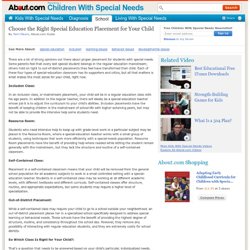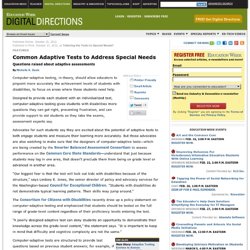

Susie
UWP non-traditional college student completing degree in Elementary Education (B-11) with Early Childhood and Special Education inclusion/minor
YouTube. YouTube. Classroom Strategies For Special Education. Updated November 06, 2008 There are many practical strategies that are effective in the classroom.

It is up to the classroom and special education teacher to ensure that appropriate strategies are being used in the classroom to assist individual learning styles and provide success to all students with special needs. It is recommended that a multi-modal approach be used, visual, auditory, kinesthetic and tactile for optimum success. Classroom Environment Provide the use of a study carrel when necessary.Seat student in area free from distractions.Eliminate all unnecessary materials from student desk to reduce distractions.Use a checklist to help student get organized.Keep an extra supply of pencils, pens, books and paper in the classroom.You may have to allow the student frequent breaks.Have an agreed upon cue for student to leave the classroom.Reduce visual distractions in the classroom. Time Management and Transitions Presentation of Materials Assessment, Grading and Testing Behavior.
Special Education Placements - Which Classroom Is Right for Your Child? There are a lot of strong opinions out there about proper placement for students with special needs.

Some parents feel that every last special student belongs in the regular education mainstream; others hold on tight to out-of-district placements they feel have transformed their child. Each of these four types of special-education classroom has its supporters and critics, but all that matters is what makes the most sense for child, right now. Inclusion Class: In an inclusion class, or mainstream placement, your child will be in a regular education class with his age peers. In addition to the regular teacher, there will ideally be a special-education teacher whose job it is to adjust the curriculum to your child's abilities.
Resource Room: Self-Contained Class: Placement in a self-contained classroom means that your child will be removed from the general school population for all academic subjects to work in a small controlled setting with a special-education teacher. Common Adaptive Tests to Address Special Needs. Published Online: October 15, 2012 Published in Print: October 17, 2012, as Features Questions raised about adaptive assessments Computer-adaptive testing, in theory, should allow educators to pinpoint more accurately the achievement levels of students with disabilities, to focus on areas where those students need help.

Designed to provide each student with an individualized test, computer-adaptive testing gives students with disabilities more questions they can get right, preventing frustration, and can provide support to aid students as they take the exams, assessment experts say. Advocates for such students say they are excited about the potential of adaptive tests to both engage students and measure their learning more accurately. “Our biggest fear is that the test will lock out kids with disabilities because of the structure,” says Lindsay E. “The test must allow students to view a range of complexity, or else you’re going to cognitively discriminate against them,” Jones says.
Special Education Testing. All Special Education articles. Sort by: Date | Title Display: Summaries | Titles only Universal Design for Learning (UDL) provides the opportunity for all students to access, participate in, and progress in the general-education curriculum by reducing barriers to instruction.

Learn more about how UDL offers options for how information is presented, how students respond or demonstrate their knowledge and skills, and how students are engaged in learning. Dysgraphia is a learning disability that affects a child's handwriting. Children with dysgraphia usually have other problems such as difficulty with written expression. Learn more about causes, the importance of early assessment, dysgraphia and spelling, and effective instructional strategies that strengthen written language skills. Learn the answers to 10 commonly asked questions that families and educators of students with disabilities have about charter schools. Learning how to write individualized IEP goals is an important first step in developing your child's IEP.
About UDL. YouTube.